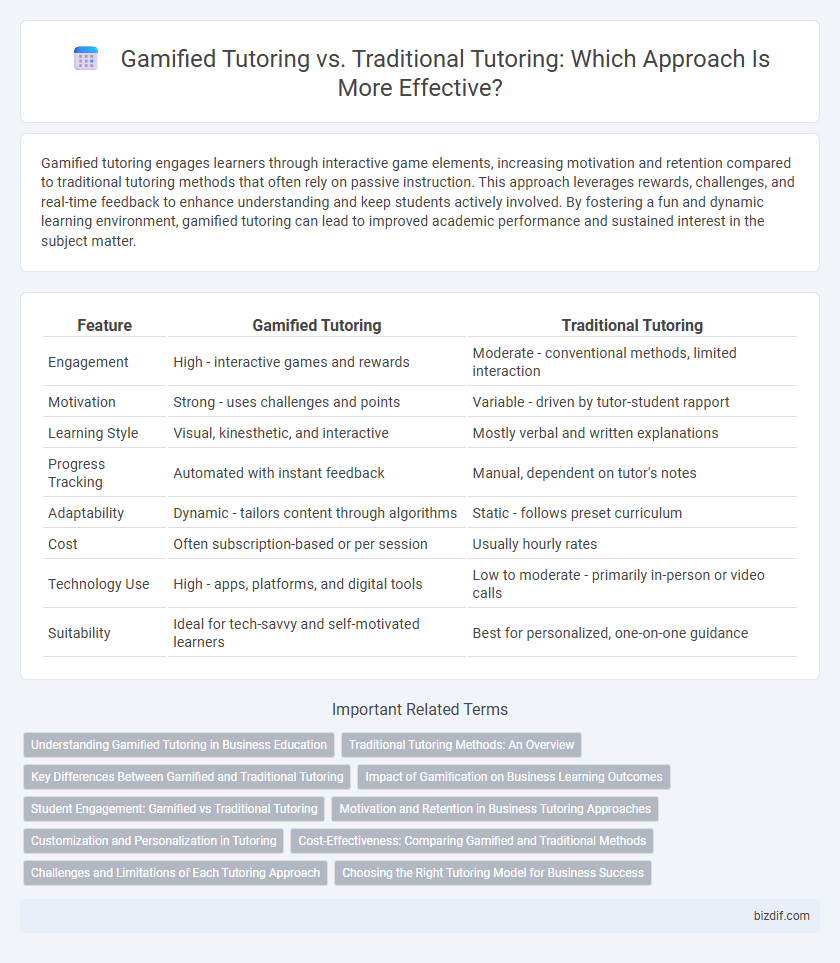Gamified tutoring engages learners through interactive game elements, increasing motivation and retention compared to traditional tutoring methods that often rely on passive instruction. This approach leverages rewards, challenges, and real-time feedback to enhance understanding and keep students actively involved. By fostering a fun and dynamic learning environment, gamified tutoring can lead to improved academic performance and sustained interest in the subject matter.
Table of Comparison
| Feature | Gamified Tutoring | Traditional Tutoring |
|---|---|---|
| Engagement | High - interactive games and rewards | Moderate - conventional methods, limited interaction |
| Motivation | Strong - uses challenges and points | Variable - driven by tutor-student rapport |
| Learning Style | Visual, kinesthetic, and interactive | Mostly verbal and written explanations |
| Progress Tracking | Automated with instant feedback | Manual, dependent on tutor's notes |
| Adaptability | Dynamic - tailors content through algorithms | Static - follows preset curriculum |
| Cost | Often subscription-based or per session | Usually hourly rates |
| Technology Use | High - apps, platforms, and digital tools | Low to moderate - primarily in-person or video calls |
| Suitability | Ideal for tech-savvy and self-motivated learners | Best for personalized, one-on-one guidance |
Understanding Gamified Tutoring in Business Education
Gamified tutoring in business education leverages game design elements like point scoring, leaderboards, and challenges to enhance student engagement and motivation. This approach fosters experiential learning by simulating real-world business scenarios, improving critical thinking and decision-making skills. Compared to traditional tutoring methods, gamified tutoring offers interactive and immersive experiences that can lead to higher retention rates and practical business acumen.
Traditional Tutoring Methods: An Overview
Traditional tutoring methods rely on direct, personalized instruction through one-on-one or small group sessions, emphasizing structured lesson plans and repetition to reinforce learning. These approaches often involve textbooks, worksheets, and oral questioning to ensure mastery of foundational concepts. While effective for individualized attention, traditional tutoring may lack the engagement and interactivity found in gamified learning environments.
Key Differences Between Gamified and Traditional Tutoring
Gamified tutoring integrates game mechanics such as points, badges, and leaderboards to enhance student engagement and motivation, contrasting with traditional tutoring's conventional instructional methods focused on direct teaching and repetitive practice. The interactive nature of gamified tutoring fosters active participation and immediate feedback, which can improve knowledge retention compared to the passive learning style often seen in traditional tutoring. Assessment in gamified tutoring typically involves adaptive challenges and reward systems tailored to individual progress, while traditional tutoring relies more on standardized testing and fixed curricula.
Impact of Gamification on Business Learning Outcomes
Gamified tutoring significantly enhances business learning outcomes by increasing learner engagement, motivation, and knowledge retention compared to traditional tutoring methods. Interactive game elements such as points, leaderboards, and challenges create immersive experiences that accelerate skill acquisition and problem-solving abilities relevant to business contexts. Research shows gamified approaches can improve completion rates by up to 40% and elevate critical thinking and decision-making skills in corporate training environments.
Student Engagement: Gamified vs Traditional Tutoring
Gamified tutoring significantly enhances student engagement by incorporating interactive elements, rewards, and real-time feedback that motivate learners to participate actively. Traditional tutoring often relies on passive instruction methods, which can lead to lower attention spans and reduced enthusiasm for the material. Studies show that gamified approaches improve retention rates and foster a more dynamic learning environment compared to conventional tutoring techniques.
Motivation and Retention in Business Tutoring Approaches
Gamified tutoring enhances motivation and retention by incorporating interactive elements such as rewards, challenges, and immediate feedback, which engage learners more effectively than traditional tutoring methods. Business tutoring leveraging gamification techniques demonstrates higher learner participation rates and long-term knowledge retention due to increased intrinsic motivation. Traditional tutoring, while effective in personalized guidance, often lacks the dynamic engagement that gamified approaches provide, resulting in lower sustained learner interest and reduced information retention in competitive business environments.
Customization and Personalization in Tutoring
Gamified tutoring leverages adaptive learning technologies to customize educational content based on student performance, preferences, and learning pace, ensuring an engaging and personalized experience. Traditional tutoring often follows a standardized curriculum with limited flexibility to tailor lessons to individual student needs, resulting in less personalized support. Emphasizing customization, gamified approaches utilize real-time data analytics to modify challenges and feedback, enhancing student motivation and learning outcomes.
Cost-Effectiveness: Comparing Gamified and Traditional Methods
Gamified tutoring often reduces costs by leveraging digital platforms that minimize the need for physical materials and one-on-one instructor hours, making it a more scalable solution compared to traditional tutoring. Traditional tutoring, while potentially more personalized, typically incurs higher expenses due to in-person sessions and resource demands. Cost-effectiveness favors gamified methods through increased engagement and automation, leading to improved learning outcomes with lower financial investment.
Challenges and Limitations of Each Tutoring Approach
Gamified tutoring faces challenges such as limited effectiveness for complex subjects and potential distractions from excessive game elements, which can hinder deep learning. Traditional tutoring often struggles with maintaining student engagement and lacks interactive elements that promote active learning. Both approaches require adaptation to individual learning styles to overcome their inherent limitations and optimize educational outcomes.
Choosing the Right Tutoring Model for Business Success
Gamified tutoring leverages interactive game elements to boost student engagement and motivation, leading to improved retention and learning outcomes compared to traditional tutoring's lecture-based approach. Businesses choosing the right tutoring model should consider target audience preferences, scalability, and technology integration capabilities to maximize profitability and client satisfaction. Data-driven customization and real-time progress tracking in gamified platforms offer significant advantages for optimizing educational impact and business growth.
Gamified Tutoring vs Traditional Tutoring Infographic

 bizdif.com
bizdif.com